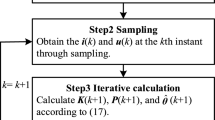Abstract
This paper presents the energy saving for separately excited direct current (DC) motor. The optimization method is adopted to calculate the field current for loss minimization. The appropriate motor and power loss parameters are important for calculating the field current for energy saving. Therefore, the deterministic recursive linear least square (DRLS) algorithm is used for the online estimation of the parameters of separately excited DC motor. Moreover, the adaptive Tabu search is used for the identification of power loss parameters. The results of the energy saving obtained using the optimization method with DRLS algorithm are compared with those obtained using the conventional and optimization methods without parameter estimation. The comparison results indicate that the optimization method with DRLS algorithm can achieve the minimum power loss for separately excited DC motor. The maximum percentage of energy saving is 77.77% compared with the conventional method.










Similar content being viewed by others
Abbreviations
- LS:
-
The least square algorithm
- DRLS:
-
The deterministic recursive linear least square
- ATS:
-
Adaptive tabu search
- OM:
-
Optimization method
- OM + DRLS:
-
Optimization method with the deterministic recursive linear least square
- \(v_{a}\) :
-
Armature voltage (V)
- \(i_{a}\) :
-
Armature current (A)
- \(R_{a}\) :
-
Armature resistance (\(\Omega\))
- \(L_{a}\) :
-
Armature inductance (H)
- \(v_{f}\) :
-
Field voltage (V)
- \(i_{f}^{{}}\) :
-
Field current (A)
- \(R_{f}\) :
-
Field resistance (\(\Omega\))
- \(L_{f}\) :
-
Field inductance (H)
- \(\omega\) :
-
Motor speed (rad/s)
- \(N\) :
-
Motor speed (rpm)
- \(K_{v}\) :
-
Voltage constant (Vs/Arad)
- \(K_{t}\) :
-
Torque constant (Nm/A2)
- \(J\) :
-
The moment of inertia (kgm2)
- \(B\) :
-
The viscous friction coefficient (Nms/rad)
- \(T_{L}\) :
-
Torque load (Nm)
- \(P_{a}\) :
-
Armature copper loss (W)
- \(P_{f}\) :
-
Field copper loss (W)
- Pm :
-
Friction and windage losses (W)
- \(K_{m}\) :
-
Constant coefficient of the friction and windage losses
- \(P_{i}\) :
-
Core losses (W)
- \(K_{h}\) :
-
Coefficients of the hysteresis loss
- \(K_{e}\) :
-
Coefficients of the eddy current loss
- PBD :
-
Brush loss (W)
- \(V_{e}\) :
-
Voltage drop across the brushes (V)
- \(P_{s}\) :
-
Stray loss (W)
- \(K_{st}\) :
-
Coefficients of the stray loss (W)
- Ploss :
-
Power loss (W)
- Pin :
-
Input power (W)
- Pout :
-
Output power (W)
- \(n\) :
-
The total data number
References
Farahani G, Rahmani K (2019) Speed control of a separately excited DC motor using new proposed fuzzy neural algorithm based on FOPID controller. J Control Autom Electr Syst 30:728–740
Kumar S, Giri V (2016) Genetic algorithms techniques based optimal PID tuning for speed control of DC motor. Am J Eng Technol Manag 1:59–64
Hameed W, Kadhim A (2016) Field weakening control of a separately excited DC motor using neural network optimized by social spider algorithm. Engineering 8:1–10
Abd-Elraouf M, El-Shenawy A (2017) Performance improvement of automatic tension control in multi coordinate drive systems for industrial paper winder. In: Nineteenth International Middle East Power Systems Conference, pp 1163–1169.
Himani RD (2016) Development of Wind Turbine emulator for standalone wind energy conversion system. IEEE 6th International Conference on Power Systems
Al Shiboul Y, Dalabeeh A, Al Shehhi K (2019) Optimal state feedback controller for separately excited DC motor. Int J Comput Sci Mob Comput 8:187–199
Pant M, Thangaraj R, Singh V (2008) Efficiency optimization of electric motors: a comparative study of stochastic algorithms. World J Modell Simul 4:140–148
Milan S, Vivek A, Paluri N (2009) A new energy optimal control scheme for a separately excited DC motor based incremental motion drive. Int J Autom Comput, 267–276
Sergaki E, Stavrakakis G, Pouliezos A (2002) Optimal robot speed trajectory by minimization of the actuator motor electromechanical losses. J Intell Robot Syst, 187–207
Issa R (2013) Separately excited DC motor optimal efficiency controller. J Eng Innov Technol 3:533–539
Zaki A, El-sattar A, Wahsh S, Mashaly H, Amer S (1998) Efficiency-optimized speed control for a separately-excited DC motor using adaptive Neuro controller. In: International Conference on Power Electronic Drives and Energy Systems for Industrial Growth, 421–426
Angelo C, Bossio G, Garcia G (1999) Loss minimization in DC motor drives. In: IEEE International Electric Machines and Drives Conference. IEMDC'99. Proceedings, 701–703
Hani S, Hassan K, Hazari R, Mannan A (2015) Speed control of separately excited DC motor with efficiency maximization propensity. The AIUB J Sci Eng 14:61–70
Udomsuk S, Areerak K-L, Areerak K-N (2015) The energy saving for separately excited DC motor drive via model based method. J Electr Eng Technol, 470–479
Young P (2011) Recursive estimation and time-series analysis. Springer, New York
Puangdownreong D, Areerak K-N, Srikaew A, Sujitjorn S, Totaron P (2002) System identification via adaptive Tabu search. In: IEEE International Conference on Industrial Technology, 915–920
Ryff P (1994) Electric machinery. Prentice-Hall International, Singapore
Chapman J (1999) Electric machinery fundamentals. Mc Graw Hill, Boston
Glover F, Laguna M (1997) Tabu search. Kluwer Academic
Kluabwang J, Puangdownreong D, Sujitjorn S (2012) Multipath adaptive tabu search for a vehicle control problem. J Appl Math 2012:1–20
Jean S, Tignol P (2001) Galois theory of algebraic equations. World Scientific, Belgium
Johan K, Wittenmark B (1995) Adaptive control. Addison-Wesley, Boston
Author information
Authors and Affiliations
Corresponding author
Additional information
Publisher's Note
Springer Nature remains neutral with regard to jurisdictional claims in published maps and institutional affiliations.
This work was supported by Suranaree University of Technology (SUT).
Rights and permissions
About this article
Cite this article
Homjan, J., Areerak, K., Areerak, T. et al. Energy saving for separately excited DC motor via optimization method with deterministic recursive linear least square algorithm. Electr Eng 104, 3955–3967 (2022). https://doi.org/10.1007/s00202-022-01593-6
Received:
Accepted:
Published:
Issue Date:
DOI: https://doi.org/10.1007/s00202-022-01593-6




